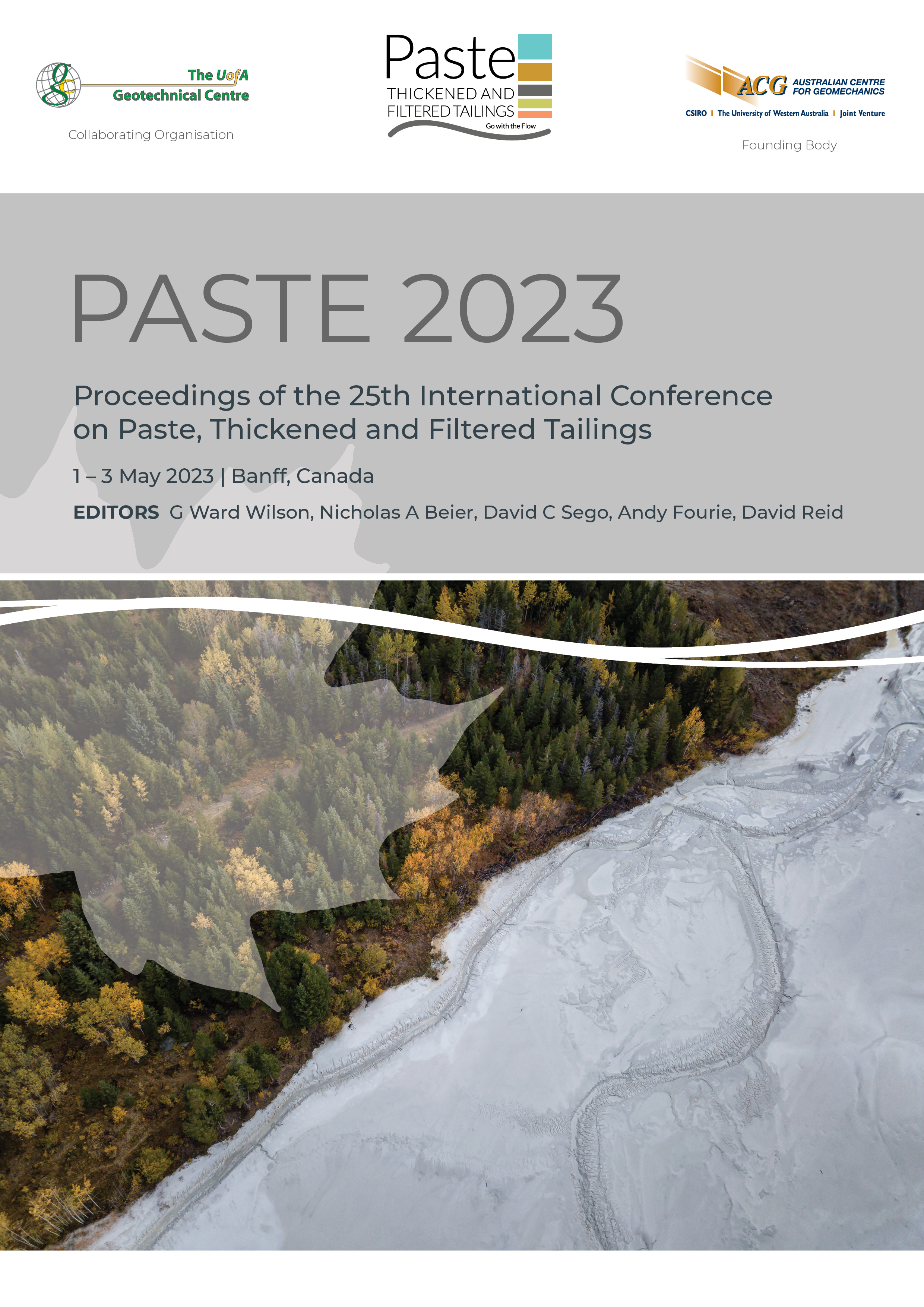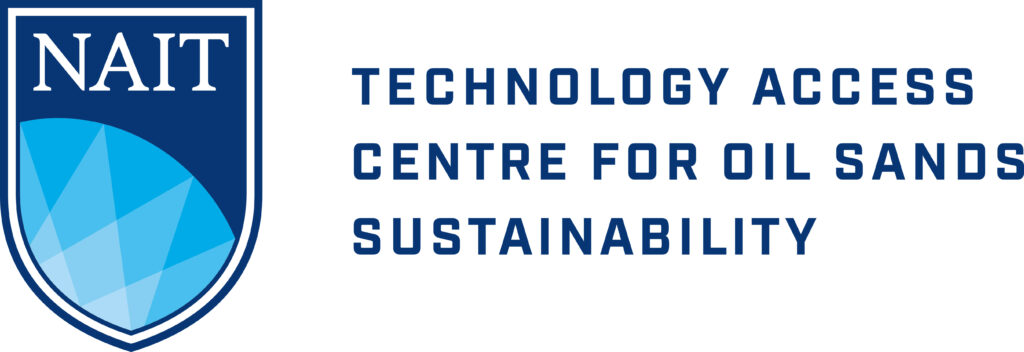Improved slurry dewatering via process water conditioning: equipment sizing and tailings storage implications

|
Authors: de Kretser, RG; Vietti, A; Dunn, F |
DOI https://doi.org/10.36487/ACG_repo/2355_26
Cite As:
de Kretser, RG, Vietti, A & Dunn, F 2023, 'Improved slurry dewatering via process water conditioning: equipment sizing and tailings storage implications', in GW Wilson, NA Beier, DC Sego, AB Fourie & D Reid (eds), Paste 2023: Proceedings of the 25th International Conference on Paste, Thickened and Filtered Tailings, Australian Centre for Geomechanics, Perth, pp. 339-353, https://doi.org/10.36487/ACG_repo/2355_26
Abstract:
The potential processing risks associated with the presence of dispersive, swelling clays in mineral orebodies are well known. Uncontrolled dispersion of such clays on contact with water results in problems including poor tailings dewatering and consolidation, increased reagent demand, dirty process water and reduced mineral recoveries and increased plant maintenance with associated economic, environmental and safety implications. Dispersive clays are typically managed via approaches including high dosages of both polymer coagulant and flocculants in thickening, high-pressure secondary dewatering steps such as pressure filtration, belt press filtration or centrifugation, or inline flocculation and deposition of thickened tailings. Commonly, the secondary dewatering step requires re-dosing of additional coagulant and/or flocculant to regenerate a flocculated structure to develop acceptable dewatering rates. An alternative, more proactive approach to managing tailings containing dispersive clays is to promote controlled dispersion of the clays by conditioning the process water circuit to induce a coagulative state in the clays on first contact, reducing clay breakup and ultra-fines generation during initial wetting of the ore on entry to the plant. Clay dispersion control via process water conditioning involves reagent dosing into the process water at only a single location, however, this delivers benefits at every stage of dewatering across the tailings management flow sheet. The potential site-wide benefits of this approach are demonstrated for the ClariVie44®process water conditioner, using a combination of flocculation and settling test results, compression-permeability testwork and pressure filtration model simulations from a range of different tailings samples. The benefits demonstrated include step changes in thickener fines capture and overflow clarity, material improvements in process plant operability and reduced down time due lower fines recirculation, elimination of coagulant dosing in the thickener and downstream secondary dewatering operations, increases in pressure filtration throughputs of up to 300%, improvements in any process technology employing secondary flocculation due to more homogenous structure development, and improved tailings storage facility (TSF) operability and lower risk due to less segregation, faster consolidation and operational dry densities and improved decant water management. Test data from the Jagersfontein kimberlite tailings are also discussed in the context of the recent TSF failure and the potential role of dispersive clays as a risk factor at this site.
Keywords: clays, filtration, consolidation, coagulation, flocculation
References:
de Kretser, RG & Scales, PJ 2007, ‘Linking local and average filtration and dewatering parameters from traditional, fluid mechanical and geotechnical theories’, Transactions of the Filtration Society, vol. 7, no. 1.
de Kretser, RG & Scales, PJ 2011, ‘Exploring the influence of feed material properties on full cycle optimisation of fill, squeeze and blow plate and frame pressure filters’, Proceedings of FILTECH 2011, Filtech Exhibitions Germany, Meerbusch.
de Kretser, RG, Saha, HK & Scales, PJ 2010, ‘Semi-empirical full cycle optimisation of fill, squeeze and blow plate and frame pressure filters’, Chemical Engineering Science, vol. 65, no. 9, pp. 2700–2706.
de Kretser, RG, Scales, PJ & Boger, DV 1997, ‘Improving clay based tailings disposal; A case study on coal tailings’, AIChEJ., vol. 43, pp. 1894–1903.
de Kretser, RG, Usher, SP, Scales, PJ, Landman, KA & Boger, DV 2001, ‘Rapid measurement of dewatering design and optimization parameters’, AIChE J, vol. 47, pp. 1758–1769.
Gräfe, M, Klauber, C, McFarlane, AJ & Robinson, DJ (eds) 2017, Clays in the Minerals Processing Value Chain, Cambridge University Press, Cambridge.
Mering, J 1946, ‘The hydration of montmorillonite’, Transactions of the Faraday Society, vol. 42, pp. 205–219.
Sequet, H, de la Calle, C & Pezerat, H 1975, ‘Swelling and structural organization of saponite’, Clays and Clay Minerals, vol. 23,
pp. 1–9.
Vietti, AJ, Rabie, SL & Ntshabele, K 2019, ‘Process water conditioning to improve slurry dewatering’, in AJC Paterson, AB Fourie & D Reid (eds), Paste 2019: Proceedings of the 22nd International Conference on Paste, Thickened and Filtered Tailings, Australian Centre for Geomechanics, Perth, pp. 295–304,
Wakeman, RJ & Tarleton, ES 1999, Filtration: Equipment Selection, Modelling and Process Simulation, Elsevier Advanced Technology, Oxford.
Walker, P 2021, ‘Back to basics of tailings operation’, in A Vince (ed.), Proceedings of the Eighteenth Australian Coal Preparation Conference, Australian Coal Preparation Society, Brisbane, pp. 290–299.
© Copyright 2025, Australian Centre for Geomechanics (ACG), The University of Western Australia. All rights reserved.
View copyright/legal information
Please direct any queries or error reports to repository-acg@uwa.edu.au
View copyright/legal information
Please direct any queries or error reports to repository-acg@uwa.edu.au



